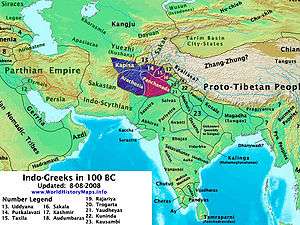Greco-Buddhism
.jpeg)
| Part of a series on |
| Buddhism |
|---|
 |
|
Greco-Buddhism, or Graeco-Buddhism, is the cultural syncretism between Hellenistic culture and Buddhism, which developed between the 4th century BC and the 5th century AD in Bactria and the Indian subcontinent, corresponding to the territories of modern-day Afghanistan, Tajikistan, India, and Pakistan. It was a cultural consequence of a long chain of interactions begun by Greek forays into India from the time of Alexander the Great, carried further by his successors' establishment of the Greco-Bactrian Kingdom and, later, Indo-Greek Kingdom, and extended during the flourishing of the Kushan Empire. Buddhism was then adopted in Central and Northeastern Asia from the 1st century AD, ultimately spreading to China, Korea, Japan, Philippines, Siberia, and Vietnam.
Historical outline
The interaction between Hellenistic Greece and Buddhism started when Alexander the Great conquered the Achaemenid Empire and further regions of Central Asia in 334 BC, crossing the Indus and then the Jhelum River after the Battle of the Hydaspes and going as far as the Beas, thus establishing direct contact with India.
Alexander founded several cities in his new territories in the areas of the Amu Darya and Bactria, and Greek settlements further extended to the Khyber Pass, Gandhara (see Taxila), and the Punjab region. These regions correspond to a unique geographical passageway between the Himalayas and the Hindu Kush mountains through which most of the interaction between India and Central Asia took place, generating intense cultural exchange and trade.
Following Alexander's death on June 10, 323 BC, the Diadochi or "Successors" founded their own kingdoms in Anatolia and Central Asia. General Seleucus set up the Seleucid Empire, which extended as far as India. Later, the eastern part of the Seleucid Kingdom broke away to form the Greco-Bactrian Kingdom (250 BC-125 BC), followed by the Indo-Greek Kingdom (180 BC - AD 10), and later the Kushan Empire (1st–3rd century AD).
The interaction of Greek and Buddhist cultures operated over several centuries until it ended in the 5th century AD with the invasions of the Hephthalite Empire and the expansion of Islam.
Cultural interraction
The length of the Greek presence in Central Asia and northern India provided opportunities for interaction, not only on the artistic, but also on the religious plane.
Alexander the Great in Bactria and India (331–325 BC)
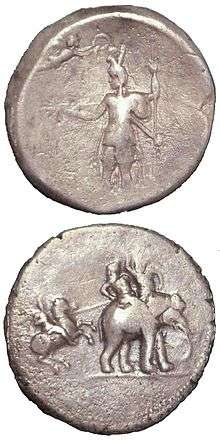
Obv: Alexander being crowned by Nike.
Rev: Alexander attacking King Porus on his elephant.
Silver. British Museum.
When Alexander invaded Bactria and Gandhara, these areas may already have been under śramanic influence, likely specifically Buddhist and Jain. According to a legend preserved in the Pāli Canon, two merchant brothers from Kamsabhoga in Bactria, Tapassu and Bhallika, visited Gautama Buddha and became his disciples. The legend states that they then returned home and spread the Buddha's teaching.[4]
In 326 BC, Alexander conquered Northern region of India. King Ambhi of Taxila, known as Taxiles, surrendered his city, a notable Buddhist center, to Alexander. Alexander fought an epic battle against King Porus of Pauravas in the Punjab, at the Battle of the Hydaspes in 326 BC.
Several philosophers, such as Pyrrho, Anaxarchus and Onesicritus, are said to have been selected by Alexander to accompany him in his eastern campaigns. During the 18 months they were in India, they were able to interact with Indian ascetics, generally described as Gymnosophists ("naked philosophers"). Pyrrho (360-270 BC) returned to Greece and became the first Skeptic and the founder of the school named Pyrrhonism. The Greek biographer Diogenes Laërtius explained that Pyrrho's equanimity and detachment from the world were acquired in India.[5] Few of his sayings are directly known, but they are clearly reminiscent of śramanic, possibly Buddhist, thought: "Nothing really exists, but human life is governed by convention. ... Nothing is in itself more this than that"[6]
Another of these philosophers, Onesicritus, a Cynic, is said by Strabo to have learnt in India the following precepts: "That nothing that happens to a man is bad or good, opinions being merely dreams. ... That the best philosophy [is] that which liberates the mind from [both] pleasure and grief".[7]
The Mauryan empire (322–183 BC)
The Indian emperor Chandragupta Maurya, founder of the Maurya Empire, re-conquered around 322 BC the northwest Indian territory that had been lost to Alexander the Great. However, contacts were kept with his Greco-Iranian neighbours in the Seleucid Empire. Emperor Seleucus I Nicator came to a marital agreement as part of a peace treaty,[8] and several Greeks, such as the historian Megasthenes, resided at the Mauryan court.

Chandragupta's grandson Ashoka embraced the Buddhist faith and became a great proselytizer in the line of the traditional Pali canon of Theravada Buddhism, insisting on non-violence to humans and animals (ahimsa), and general precepts regulating the life of lay people.
According to the Edicts of Ashoka, set in stone, some of them written in Greek[9] and some in Aramaic, the official language of the Achaemenids, he sent Buddhist emissaries to the Greek lands in Asia and as far as the Mediterranean. The edicts name each of the rulers of the Hellenistic period:
The conquest by Dharma has been won here, on the borders, and even six hundred yojanas (4,000 miles) away, where the Greek king Antiochos (Antiyoga) rules, and beyond there where the four kings named Ptolemy (Turamaya), Antigonos (Antikini), Magas (Maka) and Alexander (Alikasu[n]dara) rule, likewise in the south among the Cholas, the Pandyas, and as far as Tamraparni.[10]
Ashoka also claims he converted to Buddhism Greek populations within his realm:
Here in the king's domain among the Greeks, the Kambojas, the Nabhakas, the Nabhapamkits, the Bhojas, the Pitinikas, the Andhras and the Palidas, everywhere people are following Beloved-of-the-Gods' instructions in Dharma.[11]
Finally, some of the emissaries of Ashoka, such as the famous Dharmaraksita, are described in Pali sources as leading Greek ("Yona") Buddhist monks active in Buddhist proselytism (the Mahavamsa, XII[12]), founding the eponymous Dharmaguptaka school of Buddhism.[13]
The Greek presence in Bactria (325 to 125 BC)

Alexander had established in Bactria several cities (Ai-Khanoum, Bagram) and an administration that were to last more than two centuries under the Seleucid Empire and the Greco-Bactrian Kingdom, all the time in direct contact with Indian territory. The Greeks sent ambassadors to the court of the Maurya Empire, such as the historian Megasthenes under Chandragupta Maurya, and later Deimachus under his son Bindusara, who reported extensively on the civilization of the Indians. Megasthenes sent detailed reports on Indian religions, which were circulated and quoted throughout the Classical world for centuries:[14]
Megasthenes makes a different division of the philosophers, saying that they are of two kinds, one of which he calls the Brachmanes, and the other the Sarmanes..." Strabo XV. 1. 58-60[7]
The Greco-Bactrians maintained a strong Hellenistic culture at the door of India during the rule of the Maurya Empire in India, as exemplified by the archaeological site of Ai-Khanoum. When the Maurya Empire was toppled by the Shunga Empire around 180 BC, the Greco-Bactrians expanded into India, where they established the Indo-Greek Kingdom, under which Buddhism was able to flourish.
The Indo-Greek Kingdom and Buddhism (180 BC – AD 10)
The Greco-Bactrians conquered parts of North India from 180 BC, whence they are known as the Indo-Greeks. They controlled various areas of the northern Indian territory until AD 10.
Buddhism prospered under the Indo-Greek kings, and it has been suggested that their invasion of India was intended to protect the Buddhist faith from the religious persecutions of the Shungas (185–73 BC), who had overthrown the Mauryans. Zarmanochegas was a śramana (possibly, but not necessarily a Buddhist) who, according to ancient historians such as Strabo, Cassius Dio and Nicolaus of Damascus traveled to Antioch and Athens while Augustus (died AD 14) was ruling the Roman Empire.[15][16]
Coinage
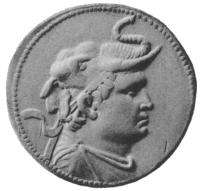

The coins of the Indo-Greek king Menander I (reigned 160-135 BC), found from Afghanistan to central India, bear the inscription "Saviour King Menander" in Greek on the front. Several Indo-Greek kings after Menander, such as Zoilos I, Strato I, Heliokles II, Theophilos, Peukolaos, Menander II and Archebius display on their coins the title "Maharajasa Dharmika" (lit. "King of the Dharma") in Prakrit written in Kharoshthi.
Some of the coins of Menander I and Menander II incorporate the Buddhist symbol of the eight-spoked wheel, associated with the Greek symbols of victory, either the palm of victory, or the victory wreath handed over by the goddess Nike. According to the Milinda Pañha, at the end of his reign Menander I became a Buddhist arhat,[17] a fact also echoed by Plutarch, who explains that his relics were shared and enshrined.[18]
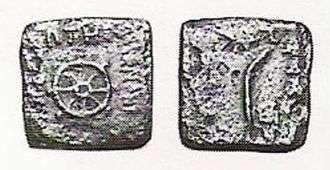
The ubiquitous symbol of the elephant in Indo-Greek coinage may also have been associated with Buddhism, as suggested by the parallel between coins of Antialcidas and Menander II, where the elephant in the coins of Antialcidas holds the same relationship to Zeus and Nike as the Buddhist wheel on the coins of Menander II. When the Zoroastrian Indo-Parthian Kingdom invaded North India in the 1st century AD, they adopted a large part of the symbolism of Indo-Greek coinage, but refrained from ever using the elephant, suggesting that its meaning was not merely geographical.
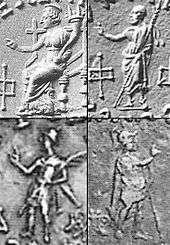
Finally, after the reign of Menander I, several Indo-Greek rulers, such as Amyntas Nikator, Nicias, Peukolaos, Hermaeus, Hippostratos and Menander II, depicted themselves or their Greek deities forming with the right hand a benediction gesture identical to the Buddhist vitarka mudra (thumb and index joined together, with other fingers extended), which in Buddhism signifies the transmission of Buddha's teaching.
Cities
According to Ptolemy, Greek cities were founded by the Greco-Bactrians in northern India. Menander established his capital in Sagala (modern Sialkot, Punjab, Pakistan) one of the centers of the blossoming Buddhist culture.[19] A large Greek city built by Demetrius and rebuilt by Menander has been excavated at the archaeological site of Sirkap near Taxila, where Buddhist stupas were standing side-by-side with Hindu and Greek temples, indicating religious tolerance and syncretism.
Scriptures
Evidence of direct religious interaction between Greek and Buddhist thought during the period include the Milinda Pañha or "Questions of Menander", a Pali-language discourse in the platonic style held between Menander I and the Buddhist monk Nagasena.

The Mahavamsa, ch. 29, records that during Menander's reign, a Greek thera (elder monk) named Mahadharmaraksita led 30,000 Buddhist monks from "the Greek city of Alexandria" (possibly Alexandria on the Caucasus, around 150 kilometres (93 mi) north of today's Kabul in Afghanistan), to Sri Lanka for the dedication of a stupa, indicating that Buddhism flourished in Menander's territory and that Greeks took a very active part in it.[20]
Several Buddhist dedications by Greeks in India are recorded, such as that of the Greek meridarch (civil governor of a province) named Theodorus, describing in Kharosthi how he enshrined relics of the Buddha. The inscriptions were found on a vase inside a stupa, dated to the reign of Menander or one of his successors in the 1st century BC.[21] Finally, Buddhist tradition recognizes Menander as one of the great benefactors of the faith, together with Ashoka and Kanishka the Great.
Buddhist manuscripts in cursive Greek have been found in Afghanistan, praising various Buddhas and including mentions of the Mahayana figure of "Lokesvararaja Buddha" (λωγοασφαροραζοβοδδο). These manuscripts have been dated later than the 2nd century AD.[22]
The Kushan empire (1st–3rd century AD)
The Kushan Empire, one of the five tribes of the Yuezhi, settled in Bactria around 125 BC, displacing the Greco-Bactrians and invading the northern parts of Pakistan and India from around AD 1. By that time they had already been in contact with Greek culture and the Indo-Greek kingdoms for more than a century. They used the Greek script to write their language, as exemplified by their coins and their adoption of the Greek alphabet. The absorption of Greek historical and mythological culture is suggested by Kushan sculptures representing Dionysiac scenes or even the story of the Trojan Horse and it is probable that Greek communities remained under Kushan rule.
The Kushan king Kanishka, who honored Zoroastrian, Greek and Brahmanic deities as well as the Buddha and was famous for his religious syncretism, convened the Fourth Buddhist council around AD 100 in Kashmir in order to redact the Sarvastivadin canon. Some of Kanishka's coins bear the earliest representations of the Buddha on a coin (around AD 120), in Hellenistic style and with the word "Boddo" in Greek script.
Kanishka also had the original Gandhari Prakrit Mahāyāna sūtras translated into Sanskrit, "a turning point in the evolution of the Buddhist literary canon"[23]
The Kanishka casket, dated to the first year of Kanishka's reign in AD 127, was signed by a Greek artist named Agesilas, who oversaw work at Kanishka's stupas (cetiya), confirming the direct involvement of Greeks with Buddhist realizations at such a late date.
Artistic influences
Numerous works of Greco-Buddhist art display the intermixing of Greek and Buddhist influences, around such creation centers as Gandhara. The subject matter of Gandharan art was definitely Buddhist, while most motifs were of Western Asiatic or Hellenistic origin.
The anthropomorphic representation of the Buddha

Although there is still some debate, the first anthropomorphic representations of the Buddha himself are often considered a result of the Greco-Buddhist interaction. Before this innovation, Buddhist art was "aniconic": the Buddha was only represented through his symbols (an empty throne, the Bodhi Tree, Buddha footprints, the Dharmachakra).
This reluctance towards anthropomorphic representations of the Buddha, and the sophisticated development of aniconic symbols to avoid it (even in narrative scenes where other human figures would appear), seem to be connected to one of the Buddha’s sayings reported in the Digha Nikaya that discouraged representations of himself after the extinction of his body.[24]
Probably not feeling bound by these restrictions, and because of "their cult of form, the Greeks were the first to attempt a sculptural representation of the Buddha".[25] In many parts of the Ancient World, the Greeks did develop syncretic divinities, that could become a common religious focus for populations with different traditions: a well-known example is Serapis, introduced by Ptolemy I Soter in Egypt, who combined aspects of Greek and Egyptian Gods. In India as well, it was only natural for the Greeks to create a single common divinity by combining the image of a Greek god-king (Apollo, or possibly the deified founder of the Indo-Greek Kingdom, Demetrius I of Bactria), with the traditional physical characteristics of the Buddha.
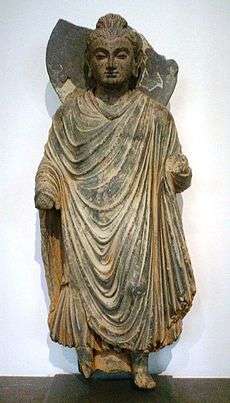
Many of the stylistic elements in the representations of the Buddha point to Greek influence: himation, the contrapposto stance of the upright figures (see: 1st–2nd century Gandhara standing Buddhas, the stylized curly hair and ushnisha apparently derived from the style of the Apollo Belvedere (330 BC) and the measured quality of the faces, all rendered with strong artistic realism. A large quantity of sculptures combining Buddhist and purely Hellenistic styles and iconography were excavated at the modern site of Hadda, Afghanistan. The curly hair of Buddha is described in the famous list of the physical characteristics of the Buddha in the Buddhist sutras. The hair with curls turning to the right is first described in the Pāli canon; we find the same description in the Dāsāṣṭasāhasrikā prajñāpāramitā.
Greek artists were most probably the authors of these early representations of the Buddha, in particular the standing statues, which display "a realistic treatment of the folds and on some even a hint of modelled volume that characterizes the best Greek work. This is Classical or Hellenistic Greek, not archaizing Greek transmitted by Persia or Bactria, nor distinctively Roman."[26]
The Greek stylistic influence on the representation of the Buddha, through its idealistic realism, also permitted a very accessible, understandable and attractive visualization of the ultimate state of enlightenment described by Buddhism, allowing it reach a wider audience:
One of the distinguishing features of the Gandharan school of art that emerged in north-west India is that it has been clearly influenced by the naturalism of the Classical Greek style. Thus, while these images still convey the inner peace that results from putting the Buddha's doctrine into practice, they also give us an impression of people who walked and talked, etc. and slept much as we do. I feel this is very important. These figures are inspiring because they do not only depict the goal, but also the sense that people like us can achieve it if we try.
During the following centuries, this anthropomorphic representation of the Buddha defined the canon of Buddhist art, but progressively evolved to incorporate more Indian and Asian elements.
A Hellenized Buddhist pantheon
Several other Buddhist deities may have been influenced by Greek gods. For example, Heracles with a lion-skin, the protector deity of Demetrius I of Bactria, "served as an artistic model for Vajrapani, a protector of the Buddha"[28] (See[29]). In Japan, this expression further translated into the wrath-filled and muscular Niō guardian gods of the Buddha, standing today at the entrance of many Buddhist temples.

According to Katsumi Tanabe, professor at Chūō University, Japan, besides Vajrapani, Greek influence also appears in several other gods of the Mahayana pantheon such as the Japanese Fūjin, inspired from the Greek divinity Boreas through the Greco-Buddhist Wardo, or the mother deity Hariti inspired by Tyche.[30]
In addition, forms such as garland-bearing cherubs, vine scrolls, and such semi-human creatures as the centaur and triton, are part of the repertory of Hellenistic art introduced by Greco-Roman artists in the service of the Kushan court.
Exchanges
Gandharan proselytism in the East

Greek monks played a direct role in the upper hierarchy of Buddhism, and in its early dissemination. During the rule (165 BC - 135 BC) of the Greco-Bactrian King Menander I (Pali: "Milinda"), Mahadharmaraksita (literally translated as 'Great Teacher/Preserver of the Dharma') was "a Greek (Pali: Yona, lit. Ionian) Buddhist head monk," according to the Mahavamsa (Chap. XXIX), who led 30,000 Buddhist monks from "the Greek city of Alasandra" (Alexandria of the Caucasus, around 150 km north of today's Kabul in Afghanistan), to Sri Lanka for the dedication of the Great Stupa in Anuradhapura. Dharmaraksita (Sanskrit), or Dhammarakkhita (Pali) (translation: Protected by the Dharma), was one of the missionaries sent by the Mauryan emperor Ashoka to proselytize the Buddhist faith. He is described as being a Greek (Pali: "Yona", lit. "Ionian") in the Mahavamsa, and his activities are indicative of the strength of the Hellenistic Greek involvement during the formative centuries of Buddhism. Indeed, Menander I was famously converted to Buddhism by Nagasena, who was a student of the Greek Buddhist monk Dharmaraksita. Menander is said to have reached enlightenment as an arhat under Nagasena's guidance and is recorded as a great patron of Buddhism. The dialogue of the Greek king Menander I (Pali "Milinda") with the monk Nagasena comprises the Pali Buddhist work known as the Milinda Panha.
Buddhist monks from the region of Gandhara in Afghanistan, where Greco-Buddhism was most influential, later played a key role in the development and the transmission of Buddhist ideas in the direction of northern Asia. Greco-Buddhist Kushan monks such as Lokaksema (c. 178 AD) travelled to the Chinese capital of Loyang, where they became the first translators of Buddhist scriptures into Chinese.[31] Central Asian and East Asian Buddhist monks appear to have maintained strong exchanges until around the 10th century, as indicated by the Bezeklik Thousand Buddha Caves frescos from the Tarim Basin. In legend too Bodhidharma, the founder of Chán-Buddhism, which later became Zen, and the legendary originator of the physical training of the Shaolin monks that led to the creation of Shaolin Kung Fu, is described as a Buddhist monk from Central Asia in the first Chinese references to him (Yan Xuan-Zhi, 547 AD).[32] Throughout Buddhist art, Bodhidharma is depicted as a rather ill-tempered, profusely bearded and wide-eyed barbarian, and he is referred as "The Blue-Eyed Barbarian" (碧眼胡:Bìyǎn hú) in Chinese Chan texts.[33] In 485 AD, according to the 7th century Chinese historic treatise Liang Shu, five monks from Gandhara travelled to the country of Fusang ("The country of the extreme East" beyond the sea, probably eastern Japan), where they introduced Buddhism:
- "Fusang is located to the east of China, 20,000 li (1,500 kilometers) east of the state of Da Han (itself east of the state of Wa in modern Kyūshū, Japan). (...) In former times, the people of Fusang knew nothing of the Buddhist religion, but in the second year of Da Ming of the Song dynasty (485 AD), five monks from Kipin (Kabul region of Gandhara) travelled by ship to Fusang. They propagated Buddhist doctrine, circulated scriptures and drawings, and advised the people to relinquish worldly attachments. As a results the customs of Fusang changed" (Chinese: "扶桑在大漢國東二萬餘里,地在中國之東(...)其俗舊無佛法,宋大明二年,罽賓國嘗有比丘五人游行至其國,流通佛法,經像,教令出家,風 俗遂改.")
Two half-brothers from Gandhara, Asanga and Vasubandhu (4th century), created the Yogacara or "Mind-only" school of Mahayana Buddhism, which through one of its major texts, the Lankavatara Sutra, became a founding block of Mahayana, and particularly Zen, philosophy.
Greco-Buddhism in the West
Intense westward physical exchange at that time along the Silk Road is confirmed by the Roman craze for silk from the 1st century BC to the point that the Senate issued, in vain, several edicts to prohibit the wearing of silk, on economic and moral grounds. This is attested by at least three authors: Strabo (64/ 63 BC–c. 24 AD), Seneca the Younger (c. 3 BC–AD 65), Pliny the Elder (23–79 AD). The aforementioned Strabo and Plutarch (c. 45–125 AD) also wrote about Indo-Greek Buddhist king Menander, confirming that information about the Indo-Greek Buddhists was circulating throughout the Hellenistic world.
Zarmanochegas (Zarmarus) (Ζαρμανοχηγὰς) was a monk of the Sramana tradition (possibly, but not necessarily a Buddhist) who, according to ancient historians such as Strabo and Dio Cassius, met Nicholas of Damascus in Antioch while Augustus (died AD 14) was ruling the Roman Empire, and shortly thereafter proceeded to Athens where he burnt himself to death.[15][16] His story and tomb in Athens were well-known over a century later. Plutarch (died AD 120) in his Life of Alexander, after discussing the self-immolation of Calanus of India (Kalanos) witnessed by Alexander writes: "The same thing was done long after by another Indian who came with Caesar to Athens, where they still show you 'the Indian's Monument,'"[34] referring to Zarmanochegas' tomb in Roman Athens.
Another century later the Christian church father Clement of Alexandria (died AD 215) mentioned Buddha by name in his Stromata (Bk I, Ch XV): "The Indian gymnosophists are also in the number, and the other barbarian philosophers. And of these there are two classes, some of them called Sarmanæ and others Brahmins. And those of the Sarmanæ who are called "Hylobii" neither inhabit cities, nor have roofs over them, but are clothed in the bark of trees, feed on nuts, and drink water in their hands. Like those called Encratites in the present day, they know not marriage nor begetting of children. Some, too, of the Indians obey the precepts of Buddha (Βούττα) whom, on account of his extraordinary sanctity, they have raised to divine honours."[35]
Buddhist gravestones from the Ptolemaic period have also been found in Alexandria in Egypt, decorated with depictions of the Dharma wheel.[36] The presence of Buddhists in Alexandria at this time is important, since "It was later in this very place that some of the most active centers of Christianity were established".[37] The pre-Christian monastic order of the Therapeutae is possibly a deformation of the Pāli word "Theravāda,"[38] a form of Buddhism, and the movement may have "almost entirely drawn (its) inspiration from the teaching and practices of Buddhist asceticism".[39] They may even have been descendants of Asoka's emissaries to the West.[40] The philosopher Hegesias of Cyrene, from the city of Cyrene where Magas of Cyrene ruled, is sometimes thought to have been influenced by the teachings of Aśoka's Buddhist missionaries.[41]
Buddhism and Christianity

Although the philosophical systems of Buddhism and Christianity have evolved in rather different ways, the moral precepts advocated by Buddhism from the time of Ashoka through his edicts do have some similarities with the Christian moral precepts developed more than two centuries later: respect for life, respect for the weak, rejection of violence, pardon to sinners, tolerance.
One theory is that these similarities may indicate the propagation of Buddhist ideals into the Western World, with the Greeks acting as intermediaries and religious syncretists.[42]
- "Scholars have often considered the possibility that Buddhism influenced the early development of Christianity. They have drawn attention to many parallels concerning the births, lives, doctrines, and deaths of the Buddha and Jesus" (Bentley, "Old World Encounters").
The story of the birth of the Buddha was well known in the West, and possibly influenced the story of the birth of Jesus: Saint Jerome (4th century AD) mentions the birth of the Buddha, who he says "was born from the side of a virgin,"[43] and the influential early Christian church father Clement of Alexandria (died AD 215) mentioned Buddha (Βούττα) in his Stromata (Bk I, Ch XV).[44]
See also
- Greco-Bactrian Kingdom
- Indo-Greek Kingdom
- Greco-Buddhist Art
- Religions of the Indo-Greeks
- Buddhas of Bamyan
- Kushan Empire
- Mathura
- Pyrrho
Notes
- ↑ Davies, Cuthbert Collin (1959). An Historical Atlas of the Indian Peninsula. Oxford University Press.
- ↑ Narain, A.K. (1976). The Coin Types of the Indo-Greek Kings, 256-54 B.C. Ares. ISBN 0-89005-109-7.
- ↑ Hans Erich Stier, Ernst Kirsten, Ekkehard Aner. Grosser Atlas zur Weltgeschichte: Vorzeit. Altertum. Mittelalter. Neuzeit. Georg Westermann Verlag 1978, ISBN 3-14-100919-8.
- ↑ Foltz, Religions of the Silk Road, p. 43
- ↑ "He would withdraw from the world and live in solitude, rarely showing himself to his relatives; this is because he had heard an Indian reproach Anaxarchus, telling him that he would never be able to teach others what is good while he himself danced attendance on kings in their court. He would maintain the same composure at all times." (Diogenes Laertius, IX.63 on Pyrrhon)
- ↑ (Diogenes Laërtius IX.61
- 1 2 Strabo, XV.I.65: "Strabo XV.1". Perseus.tufts.edu. Retrieved 2010-09-01.
- ↑ "The whole region from Phrygia to the Indus was subject to Seleucus. He crossed the Indus and waged war with Sandrocottus [Maurya], king of the Indians, who dwelt on the banks of that stream, until they came to an understanding with each other and contracted a marriage relationship. Some of these exploits were performed before the death of Antigonus and some afterward." Appian History of Rome, The Syrian Wars 55
- ↑ For an English translation of the Greek edicts: Religions and Trade: Religious Formation, Transformation and Cross-Cultural Exchange between East and West. BRILL. 2 December 2013. pp. 65–. ISBN 978-90-04-25530-2.
- ↑ Rock Edict Nb.13, Full text of the Edicts of Ashoka. See Rock Edict 13
- ↑ Rock Edict Nb13 (S. Dhammika)
- ↑ Mahavamsa, chapter XII
- ↑ Bhikkhu Sujato. Abstract: Sects & Sectarianism. The Origin of the three existing Vinaya lineages: Theravada, Dharmaguptaka, and Mulasarvastivada
- ↑ Surviving fragments of Megasthenes:Full text
- 1 2 Strabo, xv, 1, on the immolation of the Sramana in Athens (Paragraph 73).
- 1 2 Dio Cassius, liv, 9.
- ↑ Extract of the Milinda Panha: "And afterwards, taking delight in the wisdom of the Elder, he handed over his kingdom to his son, and abandoning the household life for the houseless state, grew great in insight, and himself attained to Arahatship!" (The Questions of King Milinda, Translation by T. W. Rhys Davids, 1890)
- ↑ Plutarch on Menander: "But when one Menander, who had reigned graciously over the Bactrians, died afterwards in the camp, the cities indeed by common consent celebrated his funerals; but coming to a contest about his relics, they were difficultly at last brought to this agreement, that his ashes being distributed, everyone should carry away an equal share, and they should all erect monuments to him." (Plutarch, "Political Precepts" Praec. reip. ger. 28, 6) p147–148 Full text
- ↑ Milinda Panha, Chap. I
- ↑ Thomas McEvilley (7 February 2012). The Shape of Ancient Thought: Comparative Studies in Greek and Indian Philosophies. Constable & Robinson. pp. 558–. ISBN 978-1-58115-933-2.
- ↑ Tarn, William Woodthorpe (24 June 2010). The Greeks in Bactria and India. Cambridge University Press. p. 391. ISBN 978-1-108-00941-6.
- ↑ Nicholas Sims-Williams, "A Bactrian Buddhist Manuscript"
- ↑ Foltz, Religions of the Silk Road, p. 45
- ↑ "Due to the statement of the Master in the Dighanikaya disfavouring his representation in human form after the extinction of body, reluctance prevailed for some time". Also "Hinayanis opposed image worship of the Master due to canonical restrictions". R.C. Sharma, in "The Art of Mathura, India", Tokyo National Museum 2002, p.11
- ↑ Linssen, "Zen Living"
- ↑ Boardman
- ↑ 14th Dalai Lama, foreword to "Echoes of Alexander the Great", 2000.
- ↑ Foltz, Religions of the Silk Road, p. 44
- ↑ Images of the Herakles-influenced Vajrapani: Image 1, Image 2
- ↑ Katsumi Tanabe, Alexander the Great: East-West Cultural Contact from Greece to Japan (Tokyo: NHK Puromōshon and Tokyo National Museum, 2003).
- ↑ Foltz, Richard, Religions of the Silk Road, Palgrave Macmillan, 2nd edition, 2010, p. 46 ISBN 978-0-230-62125-1
- ↑ Broughton, Jeffrey L. (1999), The Bodhidharma Anthology: The Earliest Records of Zen, Berkeley: University of California Press, ISBN 0-520-21972-4. pp. 54-55.
- ↑ Soothill, William Edward; Hodous, Lewis (1995), A Dictionary of Chinese Buddhist Terms, London: RoutledgeCurzon https://web.archive.org/web/20140303182232/http://buddhistinformatics.ddbc.edu.tw/glossaries/files/soothill-hodous.ddbc.pdf
- ↑ Plutarch. 'Life of Alexander' in The Lives of the Noble Grecians and Romans. (trans John Dryden and revised Arthur Hugh Clough) The Modern Library (Random House Inc). New York.p850
- ↑ Clement of Alexandria Stromata. BkI, Ch XV http://www.ccel.org/ccel/schaff/anf02.vi.iv.i.xv.html (Accessed 19 Dec 2012)
- ↑ Tarn, The Greeks in Bactria and India
- ↑ Robert Linssen, Zen living
- ↑ According to the linguist Zacharias P. Thundy
- ↑ "Zen living", Robert Linssen
- ↑ "The Original Jesus" (Element Books, Shaftesbury, 1995), Elmar R Gruber, Holger Kersten
- ↑ "The philosopher Hegesias of Cyrene (nicknamed Peisithanatos, "The advocate of death") was a contemporary of Magas and was probably influenced by the teachings of the Buddhist missionaries to Cyrene and Alexandria. His influence was such that he was ultimately prohibited from teaching." Jean-Marie Lafont, Inalco in "Les Dossiers d'Archéologie", No254, p.78
- ↑ "Certain Indian notions may have made their way westward into the budding Christianity of the Mediterranean world through the channels of the Greek diaspora." Foltz, Religions of the Silk Road, p. 44
- ↑ McEvilley, p391
- ↑ Clement of Alexandria Stromata. BkI, Ch XV http://www.ccel.org/ccel/schaff/anf02.vi.iv.i.xv.html (Accessed 19 Dec 2012)
References
- Alexander the Great: East-West Cultural Contacts from Greece to Japan. Tokyo: NHK Puromōshon and Tokyo National Museum, 2003.
- Jerry H. Bentley. Old World Encounters: Cross-cultural Contacts and Exchanges in Pre-modern Times. Oxford–NY: Oxford University Press, 1993. ISBN 0-19-507639-7
- John Boardman. The Diffusion of Classical Art in Antiquity. Princeton, NJ: Princeton University Press, 1994. ISBN 0-691-03680-2
- Shravasti Dhammika, trans. The Edicts of King Asoka: An English Rendering. Kandy, Sri Lanka: Buddhist Publication Society, 1993. ISBN 955-24-0104-6
- Richard Foltz. Religions of the Silk Road, 2nd edition, New York: Palgrave Macmillan, 2010 ISBN 978-0-230-62125-1
- Georgios T. Halkias, “When the Greeks Converted the Buddha: Asymmetrical Transfers of Knowledge in Indo-Greek Cultures”, in Trade and Religions: Religious Formation, Transformation and Cross-Cultural Exchange between East and West, ed. Volker Rabens. Leiden: Brill, 2013, p. 65–115.
- Robert Linssen. Living Zen. NY: Grove Press, 1958. ISBN 0-8021-3136-0
- Lowenstein, Tom (1996). The vision of the Buddha. Duncan Baird Publishers. ISBN 1-903296-91-9.
- Thomas McEvilley. The Shape of Ancient Thought: Comparative Studies in Greek and Indian Philosophies. NY: Allworth Press and the School of Visual Arts, 2002. ISBN 1-58115-203-5
- William Woodthorpe Tarn. The Greeks in Bactria and India. Cambridge: Cambridge University Press, 1951, ISBN 81-215-0220-9
- Marian Wenzel. Echoes of Alexander the Great: Silk Route Portraits from Gandhara, foreword by the Dalai Lama. Eklisa Anstalt, 2000. ISBN 1-58886-014-0
- Paul Williams. Mahāyāna Buddhism: the Doctrinal Foundations. London–NY: Routledge, 1989. ISBN 0-415-02537-0
External links
| Wikimedia Commons has media related to Greco-Buddhist art. |
- UNESCO: Threatened Greco-Buddhist art
- Alexander the Great: East-West Cultural contacts from Greece to Japan (Japanese)
- The Hellenistic age
- The Kanishka Buddhist coins
- Interim period: Mathura as the Vaishnava-Buddhist seat of culture and learning
